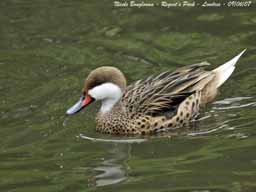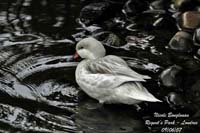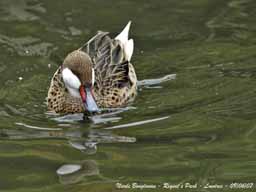
White-cheeked Pintail – Anas bahamensis
Anseriforme Order – Anatidae Family
BIOMETRICS:
Length: 38 to 50 cm; Weight: 475 to 530 g
DESCRIPTION:
White-cheeked Pintail is a medium-sized dabbling duck.
Adult has brown upperparts with black feathers bordered with pale buff on back. Tail is pointed and yellowish. Wing coverts are brown. Great coverts have yellowish tips. Tertials are blackish with pale brown edges. Secondary bases show metallic green band and black sub terminal band with broad yellowish edge on the tip.
Underparts are warm brown, spotted with black on breast and belly. Undertail coverts are yellowish. Underwing is dark, except paler central band, blackish flight feathers and pale trailing edge.


Both sexes are similar, but female has duller bill and face, and shorter tail. Female is slightly smaller than male.
Juvenile resembles adults, but with slightly duller bill and plumage.
One also finds quite white birds, mainly in captivity.

We can find three races:
Anas bahamensis bahamensis, from Caribbean.
Anas bahamensis galapagensis, from Galapagos, smaller and duller.
Anas bahamensis rubrirostris, from South America, larger and paler. This one is partially migratory, breeding in Argentina and moving northwards to winter.
VOICE: SOUNDS BY XENO-CANTO
White-cheeked Pintail is relatively silent. Male may utter a low whistle, and female weak quacking descending in pitch.
HABITAT:
White-cheeked Pintail lives in brackish and salt water, such as ponds, lagoons, lakes, mangroves, estuaries, but also shallow freshwater ponds and lakes, and open wet areas. It may be found from sea level to 2500 metres of elevation in Bolivia.
RANGE:
White-cheeked Pintail lives in Caribbean, South America and Galapagos Islands. Birds from Caribbean move to Texas and Florida.

BEHAVIOUR:
White-cheeked Pintail feeds by dabbling and up-ending its body into the water, to reach deeper food.
It is usually seen alone or in pairs, or in small group of 10 to 12 birds, but also in larger flocks of up to 100 birds and more.
It is a fearful and shy bird.
The White-cheeked Pintail is resident in Galapagos and West India. However, the race rubrirostris moves a little towards the lowlands, mostly in the northern parts of the range.

FLIGHT:
White-cheeked Pintail performs fast and agile flight.
REPRODUCTION:
Breeding varies according to the range.
White-cheeked Pintail pair forms after post-breeding moult. It may nest solitary or in small groups.
The nest is situated on the ground, near water. It is concealed among and under the thick vegetation of the shore, or among the roots in mangroves.
Female lays 6 to 10 creamy eggs. Incubation lasts about 25 to 26 days.

DIET:
White-cheeked Pintail feeds on small aquatic animals, and seeds of aquatic vegetation, but also algae.
PROTECTION / THREATS / STATUS:
White-cheeked Pintail populations seem to be stable. Some smaller populations as Galapagos subspecies may be threatened due to reduced distribution.
Fr: Canard des Bahamas
All : Bahamaente
Esp : Anade Gargantillo
Ital : Codone guancebianche
Nd : Bahamapijlstaart
Russe : Шилохвость Багамская
Sd : Bahamaand
Text and photographs by Nicole Bouglouan
Sources :
HANDBOOK OF THE BIRDS OF THE WORLD vol 1 by Josep del Hoyo-Andrew Elliot-Jordi Sargatal - Lynx Edicions - ISBN: 8487334105
GUIDE DES CANARDS, DES OIES ET DES CYGNES – de Steve Madge - Delachaux et Niestlé - ISBN: 2603013769
Wikipedia (Wikipedia, The Free Encyclopedia)
What Bird-The ultimate Bird Guide (Mitchell Waite)